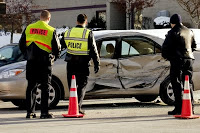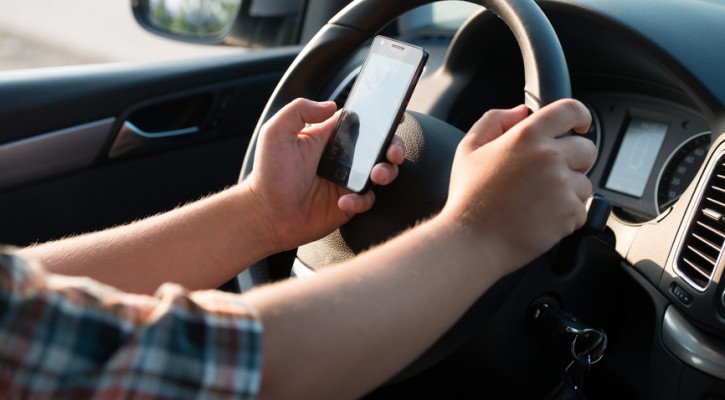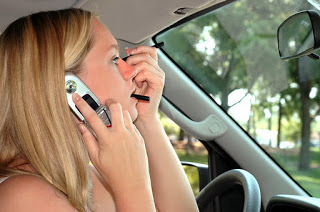Category Archive: Parents

Winnebago School Board Says Driver’s Ed Is A Privilege, Not A Right
April 5, 2007
Drawing on a tactic long used by parents to influence their teenager’s actions, schools are now dangling the car keys in front of students as a motivator. The Winnebago school board in Illinois has decided to place a bit of extra responsibility on its sophomore students, letting their grades decide if they are eligible to take a school sponsored driver education program.
Following in the footsteps of other regulations within the district applying to sports and other activities, students must now maintain a 2.0 grade point average in order to participate in the school’s driver education program. Placement in these classes is highly sought after, as they cost half of what instruction at a private driver’s education course would.
This restriction adds to the ever-growing list of laws and regulations regarding teenage drivers, frustrating students a bit. However, the additional monitoring and responsibility will only lower the risks related to the youngest of drivers.
Some of the other laws, besides the new grade requirements, include:
- Cell phones may not be used while driving.
- Drivers may not have more than one unrelated passenger under the age of 20 in their vehicle within the first 6 months of being licensed.
- Teen drivers must be off the roads before 11 pm on weekdays and midnight on weekends.
All of these regulations have been put in place to reduce the accident rate among teenage drivers. Insurance Institute for Highway Safety studies show that the accident rate per mile for drivers under twenty years old is four times that of an experienced driver. The youngest of these drivers, at sixteen years old, are involved in twice the number of accidents as the eighteen and nineteen year old drivers.
The Winnebago school district has already passed this plan within their own district, however it is not finalized for next fall as of yet. Since the Illinois State Board of Education rules are more relaxed, they must apply for a waiver to tougher their own school’s restrictions. Once this waiver is approved, the plan will start in the school year immediately following.
Create your own customized Teen Driving Contract online based on the core principles of the Driver Education Handbook for Parents and Florida’s Graduated Licensing laws.

Teens Sharpen Driving Skills Using Collision Avoidance Training
February 26, 2007
Teens learn to drive by experience. However, many of the things that happen behind the wheel cannot be prepared for under normal circumstances. Reactions to blown tires, icy roads, and collisions are a few of the things that teen drivers do not know how control. Enter CAT Training.
CAT Training, otherwise known as Collision Avoidance Training, is offered many places nationwide. No place is it more needed, however, than at a local sports complex in D’Iberville, Mississippi. In this state, teens are allowed to be licensed at age 15, and without passing a driver’s education course no less. With the deaths of 26 young people in recent years, the time felt right to bring in such a program as CAT Training.
Here, in Harrison County, CAT training was given a trial run, and will soon be offered to the public for a nominal fee. The testing group included four school resource officers who will become the course teachers. Students selected by the officers also tested the course, which is said to provide experience that normally takes five to seven years of driving experience to gain.
This program is the first of its’ kind in Mississippi, and was made possible by the Partners for Highway Safety Foundation. After their son died at age 17 in an auto vehicle crash on Mother’s Day weekend 1992, Paul and Ann Burris created the Partners for Highway Safety Foundation in an effort to educate teen drivers of the dangers of risky driving.
National studies show that more than 70% of crashes that involve teen drivers or passengers are avoidable. Inexperience is listed as a factor more important than the abuse of drugs or alcohol in this statistic.
Future dates that the course will be held, as well as costs to attend, have not yet been determined. However, students interested can contact Harrison County officials for information, and they will be notified as soon as the course is open to the general public.

National Teen Driver Survey Highlights Distractions on the Road
February 15, 2007
It has been said time and again, that inexperience is the number one reason teen drivers and their passengers are at risk of injury or death as a result of car accidents. A combination of immaturity, inexperience, and indifference all add to the problem. Teen drivers haven’t had the opportunity to learn which distractions are dangerous when behind the wheel, and the consequences of letting those get in the way of safe driving.
When the community understands why teen drivers act the way they do behind the wheel, educating them becomes a whole lot more productive. Therefore, studies are done nationwide to determine the safe and risky habits of teen drivers and their passengers.
One such study, sponsored by Children’s Hospital of Philadelphia and State Farm Insurance Company, asked teens what actions performed during driving were unsafe. You might be surprised by some of their answers.
According to the National Teen Driver Survey, which gathered scientific data on more than 5,600 high school students, teens reported seeing the following distractions taking place at least some of the time:
- 93% said they see peers riding with teenage driver, who are often singing, bouncing in their seat or acting wild.
- 92% reported seeing teen drivers speeding.
- 85% reported loud music from cars of teen drivers.
- 79% said they see teens sing and even dance while driving.
- 76% said they see teens drive while struggling with negative emotions, such as failing grades or relationships.
- 53% said they see teens using hand held games and listening devices or sending text messages while driving.
- 38% said they have seen teens drive after smoking marijuana.
With distractions such as singing, dancing, or dealing with life’s problems, it’s easy to see why auto accidents are the leading cause of deaths for teen drivers. We all know how hard it is to drive while just changing the radio station, let alone holding and pushing buttons on a cell phone or mp3 player. Teen drivers need to know these distractions can be deadly, and hopefully this study combined with quality driver education classes will bring this issue to light.

Teen Driving Video an Eye-Opener for Parents
February 13, 2007
I just watched a video on Drivers Ed Direct, courtesy of Geico, that shows teens driving with hidden cameras and no scripts. As a teen, I shouldn’t be surprised, but I’m sure a few parents will be when they see it.
The video follows four teens over the period of a few days, as they prepare for their homecoming game and prom. They’re interviewed candidly about their views on teen driving, wearing seatbelts, and speeding. The teens driving history ranges from 1 to 24 months of behind the wheel experience, and it is quite obvious that most states need graduated licensing laws, which make teens put more hours behind the wheel before being licensed.
All but one of these teens claim to be decent drivers, and while all voice concern over the lives of themselves and their passengers, their actions do not back up their words.
- Jesse admitted that at intersections, she will only “roll through” if there are no other cars. Hidden cameras caught her failing to stop at 5 stop signs during the same trip across town.
- Hidden cameras caught all teens either talking on their cell phone, high-fiving their back seat passengers, looking back at passengers, or gesturing to the point of having both hands off the wheel.
- One driver admitted she did not have a special policy about passengers wearing seat belts, and in fact, a hidden camera showed her driving around with her passenger unbelted.
- One driver admitted some of his friends did not want to ride with him. A hidden camera showed another driver’s passenger getting freaked out by the driver’s risky behavior (speeding).
- Both male drivers admitted to being aggressive drivers and engaging in road rage behaviors.
The video, which can be found on www.driverseddirect.com, ends with some scary statistics.
- 2/3 of teen passenger deaths occur while a teen is driving
- more than 1/3 of teen crashes are speed-related (2,150 each year)
- 74,000 young people die or are injured each year by not wearing a seat belt
- during their 1st year of driving, 1 out of 5 16-year-olds will have an accident
- there were 1,825,000 young people in accidents last year – 5,900 of them died
Parents beware. When your teen tells you he or she is a good driver, put your faith in them, but do frequent ride-alongs with them to evaluate their ongoing progress. Teens can always learn more about safe driving and the rules of the road with this online DMV test that contains hundreds of questions and answers from the Driver’s License manuals.
Emergency Maneuvers Driving Course a Good Option for Teen Drivers
January 30, 2007
Teen drivers must pass a driver’s education course and behind the wheel training before they get their license. However, what prepares them for emergency situations once they begin driving on their own? This would be one of those times when learning by experience is not the best or safest idea. Unfortunately, chances are unless you and your teen live in an area with adverse weather, they will not get a chance to practice emergency situations until it is too late.
Now there are many new driver prep course options for parents and teen drivers who wish to be fully prepared when behind the wheel. Many cities are offering emergency maneuvers driving courses, usually at a fairly reasonable cost, that teach teens how to handle emergencies while on the road. Among the types of lessons learned, teen drivers will learn things such as how to steer out of a skid and avoiding overcorrecting when swerving to miss something or someone in the road.
It is hard to prepare teen drivers for emergencies, as experience really is the greatest teacher. Fortunately now parents can enroll their teens in these new programs for greater confidence on the road. A few such programs are the Street Survival and Driver’s Edge programs. Street Survival is sponsored by the BMW Car Club of America Foundation, and is staffed with automobile lovers and high-performance driving instructors. Because the teachers are volunteer, the courses are offered at an affordable rate ($60 for parent and teen, including breakfast and lunch).
Driver’s Edge is sponsored by Bridgestone, which is offered in a dozen cities for free. More and more these types of programs are becoming available. Though they are voluntary and not required for a teen to be licensed, parents will find the costs are worth the added confidence their teen drivers will have while driving.
While some insurance companies are offering discounts to safe drivers and those with a higher grade point average, most do not yet offer a discount for completion of an emergency maneuvers driver education course. There is still a misconception that the added confidence will add to more risky driving by the teens behind the wheel. Only time and statistics will tell if these programs are effective against the onslaught of teenage driving deaths. Until then, I recommend all concerned parents have their teens enroll in such a program, or at the very least teach their child the basics themselves.
